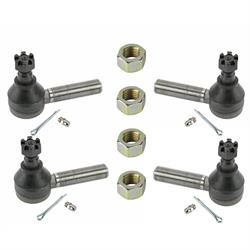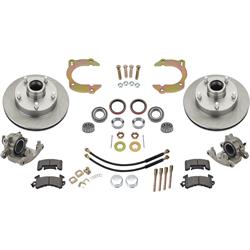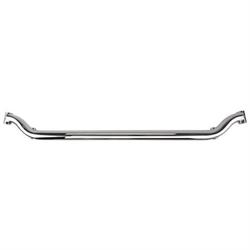Ford And Chevy Spindle Options For Solid Axle Hot Rods
For Some It Is Straight Axle or No Axle!
Hot rodders always seem to come back to the basics. After spending several decades adapting a variety of independent front suspensions to pre-'48 vehicles, rodders are again embracing solid-axle, transverse leaf spring front suspensions. The revival of the Gasser look even has straight axles being shoved under many '50s- and '60s-era muscle cars.
All of this new interest in old suspensions can generate a lot of questions from those just entering the hobby. Heck, it can even be confusing for those who have been around for years. One common conundrum is deciding which spindles to use on your early Ford-style front axle. Today's rodder can scrounge for one of several styles of original Ford spindles or select from reproduction versions of the same. Another popular option is using reproduction 1949-54 Chevy-style spindles on a tube axle. Given such choices, the selection process can get a little puzzling.
A Little History on Straight Axle Hot Rod Spindles
In the early days of hot rodding, spindle choice was somewhat obvious; you put a Ford spindle on a Ford axle. But even then there was some mixing and matching to be done. One common swap was to use 1937-1948 Ford spindles on earlier Ford axles. This allowed hot rodders to use the much better hydraulic drum brakes (AKA "juice brakes") rather than mechanical drums. Later on, hot rodders learned to adapt F-100 truck brakes and larger Buick finned drum brakes to these spindles.
As street rodding evolved in the late 1960s and 1970s a quest for better brakes led some hot rodders to adapt 1949-1954 Chevy passenger car spindles to early Ford axles. The Chevy spindles had the advantage of using hubs that were separate from the brake drums. And since Corvettes used essentially the same style spindles through 1962, you could remove the brake drum assembly from the Chevy hub and slip a Corvette disc brake rotor in its place. Then it was simply a matter of fabricating a caliper bracket out of flat plate and, Voila! you had disc brakes on your hot rod!
Chevy spindles offered additional benefits beyond disc brakes. Back in the '70s and '80s, they were much more plentiful in junkyards than early Ford pieces. And unlike Ford spindles, the Chevy pieces had separate bolt-on steering arms, making it easy to fabricate custom dropped arms for dropped axles. It also made it easier to flip the steering arms around and locate the tie rod in front of the axle, a common practice on T-buckets at the time. In a similar vein, hot rodders building straight-axle Gasser-style cars could mount the steering arms on the tops of the spindles, making it easier to connect a steering system on these jacked-up rides.
The Chevy spindle swap required a bit of work to pull off on stock Ford beam axles. You had to bore out the kingpin boss on the axle to accept the larger Chevy kingpin and machine the ends since the Chevy kingpin was shorter. The Chevy spindles were also designed for a different kingpin inclination than Fords, so it was necessary to heat and bend the axle ends to get proper camber. To help avoid this work, many manufacturers began building tube axles specifically designed to accept Chevy spindles.
As time went on, other disc brake choices became available for Chevy spindles. One option employed Volvo parts. Others used later-model GM rotors and calipers, which required some machine work on the spindles. In fact, Speedway Motors offers a machining service for customers who want to modify their original Chevy spindles to accept newer disc brakes.
Which Spindle Fits Your Straight Axle
To know what spindles you need for your traditional straight axle front suspension build we need to start with the foundation of it all, the straight axle itself. Unless you have the experience to know what you're looking at it is going to take some careful measuring to determine if the straight axle you have is a Ford or Chevy version (that is unless you bought a new axle of course). The primary difference can be found in the kingpin boss area.
To confirm if your axle is Ford or Chevy spec you will need to measure the axle's king pin boss. The king pin diameters and axle boss height are different between the axles. There is a kingpin inclination difference as well, but that is much harder to measure accurately. To take these measurements we suggest dial calipers or digital calipers. In our photo here the Ford axle is shown above the Chevy. Even with the naked eye you can see the angle differences between the two. Care to learn more about straight axles? If so, be sure to read our Toolbox buyer's guide on straight axles to get all the details before you buy.
1937-1948 Ford Axles
- 2.375-inch axle boss height
- .813-inch king pin diameter
- 5.5-inch pin length (37-41), 6-inch pin length (42-48)
1949-1954 Chevy Axles
- 2.125-inch axle boss height
- .867-inch king pin diameter
- 6.3-inch pin length
King Pins: Bushings vs Bearings
While we're on the subject of kingpins, we wanted to briefly touch on the original bushed kingpin design and the more modern bearing supported update design that has become popular. Original kingpins used a bronze bushing that is pressed into the spindle and then reamed to the proper size. We offer a standard kingpin bushing set for the popular 1937-1941 Ford spindle. Bearing style king pins have a precision needle bearing which is pressed into the spindle. The needle bearing pivot provides superior strength and smoother, easier turning than bushings. While the bearing style kingpin kit costs more, it is a very worthy upgrade in our opinion.
Modern Spindle Options That Will Fit Your Straight Axle
We consulted the seasoned tech experts at Speedway Motors to help make sense of the straight-axle spindle choices available to modern hot rodders for their builds. Speedway Motors manufactures both Ford- and Chevy-style spindles. Each style is made using a high-quality forging process and high nickel content steel, so they are exceptionally strong and durable, especially in the case of the Ford spindle, as originals were not forged and were weaker than their original Chevy counterparts. They are also manufactured with updated designs that make them superior to original components. This offers hot rodders plenty of versatility without the need to scrounge for old parts or farm out expensive machine work. So if strength and availability are no longer issues, what criteria should you use to choose between Ford- and Chevy-style spindles?
Hot rodders seeking an authentic nostalgic look will naturally gravitate toward Ford-style spindles. Speedway's reproduction versions are the round-back, 1937-41 style, and are designed to use bolt-on steering arms for more versatility. You can use them with drum brakes, such as our awesome looking Buick-style finned drum for a true period appearance. We even offer our Buick-style finned drums in a complete drum brake kit with Ford spindles. Or select from several different styles of disc brake kits, including 5 on 4-1/2 Ford bolt pattern or 5 on 4-3/4 Chevy bolt pattern for improved modern braking. Ford-style spindles will almost always be your best choice when using an original Ford axle or aftermarket beam axle.
Chevy-style spindles are a great choice for a variety of applications using tube axles. A shorter, thicker axle stub makes it a stronger design than the Ford spindle, which is worth considering on larger, heavier street rods. Speedway Motors' version of the spindle is built to direct mount common GM and Ford disc brake rotors, giving you the same choice of 5 on 4-1/2 Ford bolt pattern or 5 on 4-3/4 Chevy bolt patterns using either 9-1/4-inch Mustang II rotors or 11-inch rotors, without machine work or adapters. It also has improved kingpin geometry to work better with modern radial tires. Speedway offers two styles of steering arms for these spindles in zinc or chrome finishes; for both traditional or cross steering and, as noted earlier, the arms can easily be mounted to the top or bottom of the spindle. This makes them a good choice for Gasser-style straight axle setups.
Shown here are just a few examples of the Ford steering arms that Speedway Motors offers. Depending upon your application, you may need steering arms constructed from flat plate steel (right), flame cut steel (left), or original style forged steel (middle, and in this case also with a 1-inch drop built in). We offer steering arms for both traditional and cross steer applications. Cross steer applications are noted by the second hole in the passenger steering arm for the drag link.
Chevy spindles will always use flat steel steering arms. Speedway Motors offers several variants in zinc or chrome plated and for traditional (right) and cross steer (left) applications.
Note that the type of steering arm you end up using will determine the end joint you will need for your tie-rod ends, drag link ends, and so forth.
Updated by Mark Houlahan










